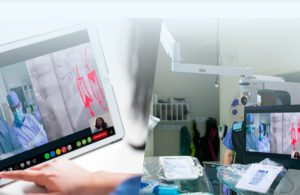
Much like a normal Starbucks-goer expects the coffee to taste a certain way at any location, Daniel Hawkins wants that type of experience in the operating room.
The CEO of Avail Medsystems, a company developing telemedicine equipment that can connect surgeons, interventional specialists and medical device sales reps, Hawkins and the team at Avail have created a set of purpose-built hardware and software that’s exactly the same in every location it’s installed.
With the uniformity across all locations, Avail designed its platform to ensure what Hawkins describes as a pure user experience akin to going to different franchises offering the same product and quality.
“In order to collaborate in the operating rooms, the experience has to be the same every time,” Hawkins told MassDevice. “You need to be able to rely on it. Our customers are not only physicians and providers, they’re — very importantly — the medical device industry. The medical device industry needs to know that every time one of their clinical specialists, salespeople, management, internal marketing, engineers or senior leadership logs on to the Avail platform to speak to one of their customers, it’s exactly the same every time.
“We’ve built that technology and we’re building that network.”
Hawkins has spent nearly 30 years in the medtech industry. He was one of the first people at Intuitive Surgical, a leader in surgical robotics with its da Vinci platform. He spent time starting companies, including CeQur and Shockwave Medical, the latter of which subsequently went public.
After leaving Shockwave, Hawkins started Avail in an effort to provide support for clinical procedures at the future intersection of technology and procedural healthcare, something he said there remains a need for.
“[The intersection of technology and procedural healthcare] demands collaboration and really relies on a consistent set of technologies in the operating rooms to enable what I’m convinced is a future world where artificial intelligence and machine learning help to guide and derive the next wave of medical technology advances,” Hawkins said. “That’s why I started Avail and built it the way I have.”
Hawkins said that Avail has master service agreements with integrated delivery networks and individual hospitals and individual providers totaling just shy of 1,000 physical facilities across the country.
What the company is doing is enabling fluid collaboration between providers and industry, he said, providing the opportunity for the broad-based application of AI and machine learning tools from outside the operating room to inside the operating room on a consistent platform with both hardware and software.
“The future of medicine — in my view, the next wave of medical advances — will be largely digitally driven inside the procedure room,” Hawkins said. “There needs to be a consistent input-output capability, display capability and computing power at the edge. The vision for Avail is building that network of capability, so that an app store of other peoples’ software, as well as our own, becomes available to bring care to patients.”
Hawkins is not alone in his vision for the future of the operating room. In early May, he participated in the “How technology is changing the OR” panel at DeviceTalks Boston, alongside representatives from Stryker, Proximie and Activ Surgical.
On that panel, Hawkins explained that bringing real-time capabilities into the OR takes decision-making to the next level for surgeons, as computer vision or AI allows users of the technology to look around the corner at things the naked eye may not be able to predict. Proximie CEO Nadine Hachach-Haram pointed out that these capabilities must be capable of evolving down the line, much like Hawkins told MassDevice weeks later.
“The quality of care has improved access, but how does it ultimately make sure every patient is getting the best care the first time, every time?” Hachach-Haram said at the event last month. “With that in mind, value and impact was always front of mind. … We recognized that we needed to build something fit for now that fit for the future as well.”
Hawkins said that “we’ve crossed the tipping point” inside medical device companies and providers where it’s less about demonstrating that something is useful in an operating room and it is now very regularly the idea that the technology enables physicians to do things they couldn’t do before.
The COVID-19 pandemic shone what Hawkins described as a “bright, white-hot spotlight” on the need for remote collaboration and in many ways accelerated interest and engagement with the Avail platform in particular, which could prove to be a jumping off point for the industry to continue to change in the way Hawkins sees it moving.
“We are on the doorstep of the next wave of hardware and operating rooms, moving the medical device industry through enhanced capability to improve patient care,” Hawkins said. “With that hardware, the Avail network in operating rooms and computer-driven capability being delivered through the Avail network. The Medical device companies that embrace and adopt that will have significant advantages.
“The future of surgery and procedural healthcare will be digitally driven by AI, machine learning and computer vision tools. Those who leverage the Avail network to be able to deliver that capability to their customers will be the winners.”